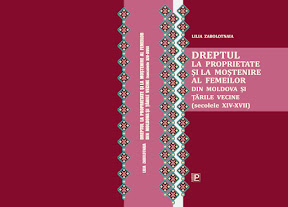  Events Archive Events Archive
Book issue „Dreptul la proprietate și la moștenire al femeilor din Moldova și țările vecine (secolele XIV-XVII). Studii și documente” by Lilia Zabolotnaia
February 23rd, 2016
Tuesday, February 23rd, 2016, 15.00 hours, at the National Museum of History of Moldova (Blue Hall) was issued the volume: Lilia Zabolotnaia „Dreptul la proprietate și la moștenire al femeilor din Moldova și țările vecine (secolele XIV-XVII). Studii și documente". (Property and inheritance rights of women in Moldovan and neighboring countries (fourteenth to seventeenth centuries). Studies and documents). Seria Istoria la feminin, Editura: Lexon-Prim, Chișinău, 2015, -351 p. The publication provides new insights and valuable research suggestions for women history - a new discipline of historical anthropology, distant from political and economic areas. This field was for a long time absent from the focus of fundamental academic research. The study is an analysis of the social and legal status of women in medieval society in Moldova compared with that of Walachia and Transylvania, also with that of Poland, Lithuania, Hungary, Bulgaria, Serbia and Russia.
For the first time were approached, using the comparative method, the following issues: legal status, social and economic impact of women in the family and society: equal rights with men to property and inheritance of property (movable and immovable), right of women to divorce, the right and hereditary succession of illegitimate children (to power and property) etc.
The originality of the work lies in defining a new definition of social and legal status of women in Moldova, achieved through methodical comparison of the characteristics unique to Moldova with those in other countries. This study of status highlighted the particularity of Moldova in the research field, revealing unknown features. One important conclusion of the study is the unique legal situation of women in medieval Moldova in European wider context - Moldovan women had many legal freedoms and privileges guaranteed by law and customary land.
The monograph is important under a practical aspect by highlighting certain interdisciplinary areas little known and researched: family history, privacy, spiritual and moral development of society, everyday mentality, history of personalities, women's history, political, social and economical history seen through human and demographic factors, sociology and history of law etc.
The volume represents a new vision of women history and serves as a source of research for professionals interested in the field and reading enthusiasts that will be captivated by new pages of a different history.
The launch event was attended by researchers, museographers, university professors, representatives of the accredited diplomatic corpse in Chisinau. Speakers: dr. hab., prof. Eugen SAVA, general director of the National Museum of History of Moldova; dr. hab., prof. Victor ŢVIRCUN, coordinating academician of Humanities and Art Section of ASM; dr. hab. Mariana ȘLAPAC, corresponding member of ASM; dr. Tamara NESTEROV, coordinating researcher at the Institute of Cultural Heritage of ASM; dr. Ana BOLDUREANU, head of Medieval History and Numismatics Section of the National Museum of History of Moldova; dr. Alina Felea, senior researcher at the Institute of History of ASM; journalist Boris MARIAN.
Connected with the book issue is the exhibition "Women History in Images" organized on the upper lobby of the museum. The exhibition offers the public an opportunity to see old women images preserved on wall pictures (frescoes) and portraits owned by museums abroad or kept in private collections, images that present in a kaleidoscopic way the historical past, capturing everyday life, spirituality and morality of each period.
|




















































